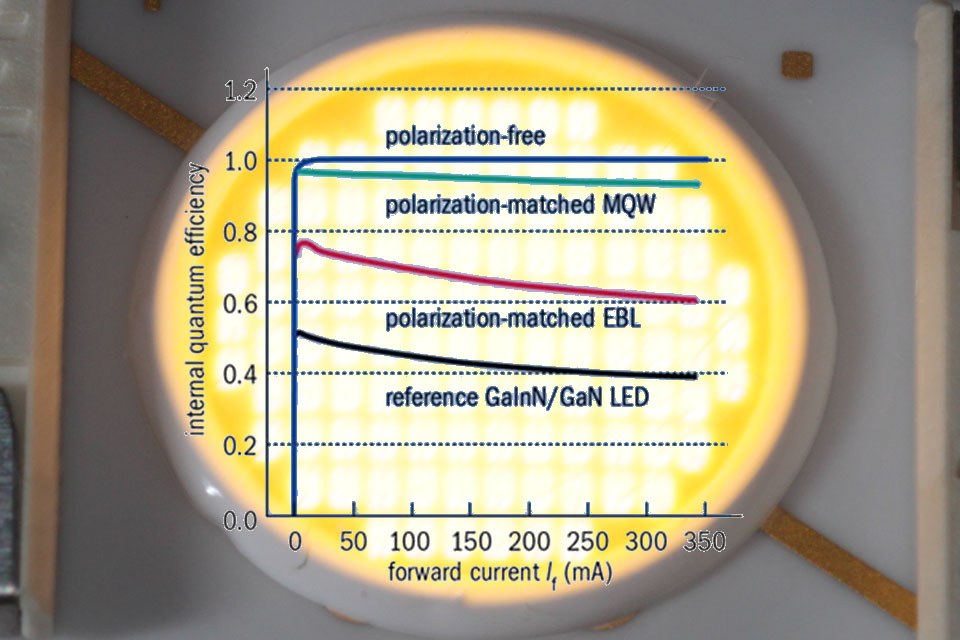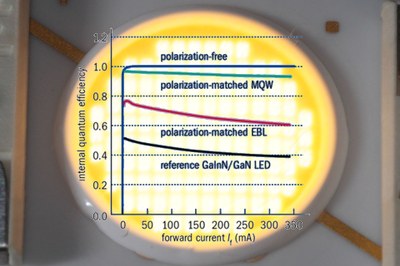Theorists from UC Santa Barbara Claim that LED Efficiency Puzzle Is Solved
Researchers at the University of California, Santa Barbara, say they’ve figured out the cause of a problem that’s made light-emitting diodes (LEDs) impractical for general lighting purposes. Their work will help engineers develop a new generation of high-performance, energy-efficient lighting that could replace incandescent and fluorescent bulbs.
“Identifying the root cause of the problem is an indispensable first step toward devising solutions,” says Chris Van de Walle, a professor in the Materials Department at UC Santa Barbara who heads the research group that carried out the work.
Van de Walle and his colleagues are working to improve the performance of nitride-based LEDs, which are efficient, non-toxic and long-lasting light sources. They investigated a phenomenon referred to as “droop”—the drop in efficiency that occurs in these LEDs when they’re operating at the high powers required to illuminate a room. The cause of this decline has been the subject of considerable debate, but the UC Santa Barbara researchers say they’ve figured out the mechanism responsible for the effect by performing quantum-mechanical calculations.
LED droop, they conclude, can be attributed to Auger recombination, a process that occurs in semiconductors, in which three charge-carriers interact without giving off light. The researchers also discovered that indirect Auger effects, which involve a scattering mechanism, are significant—a finding that accounts for the discrepancy between the observed degree of droop and that predicted by other theoretical studies, which only accounted for direct Auger processes.
In nitride LEDs, “These indirect processes form the dominant contribution to the Auger recombination rate,” says Emmanouil Kioupakis, a postdoctoral researcher at UC Santa Barbara and lead author of a paper published online April 19 in Applied Physics Letters. The other authors are Van de Walle, Patrick Rinke, now with the Fritz Haber Institute in Germany, and Kris Delaney, a project scientist at UC Santa Barbara.
LED droop can’t be eliminated because Auger effects are intrinsic, but it could be minimized, the researchers say, by using thicker quantum wells in LEDs or growing devices along non-polar or semi-polar growth directions in order to keep carrier density low.
“With Auger recombination now established as the culprit, we can focus on creative approaches to suppress or circumvent this loss mechanism,” Van de Walle says.
The work was supported by the Center for Energy Efficient Materials, an Energy Frontier Research Center funded by the U.S. Department of Energy, and by UC Santa Barbara’s Solid State Lighting and Energy Center.
Computational resources were provided by the U.S. Department of Energy’s National Energy Research Scientific Computing Center at Lawrence Berkeley National Laboratory, the California NanoSystems Institute’s Computing Facility at UC Santa Barbara, and the National Science Foundation-funded TeraGrid.
Reference:
“Indirect Auger recombination as a cause of efficiency droop in nitride light-emitting diodes”
doi: 10.1063/1.3570656
About Center for Energy Efficient Materials:
The Center for Energy Efficient Materials (CEEM) is one of 46 Energy Frontier Research Centers funded by the U.S. Department of Energy to address critical energy challenges through technological advancements. The Center was launched in August 2009 and focuses on fundamental research in three key areas: photovoltaics, thermoelectric, and solid-state lighting. It is led by UC Santa Barbara in partnership with researchers at the National Renewable Energy Laboratory, the Los Alamos National Laboratory, the University of California, Santa Cruz, and Harvard University. For more information, visit: ceem.ucsb.edu.
About Solid State Lighting and Energy Center:
The Solid State Lighting and Energy Center (SSLEC) is focused on new semiconductor-based technologies for energy-efficient lighting and displays, power electronics, and solar energy conversion. The objective of the SSLEC is to provide a forum for its members—key industry partners and faculty and student researchers at UC Santa Barbara—to work in collaboration and across scientific disciplines to address the most challenging problems in these important and timely areas of research.


